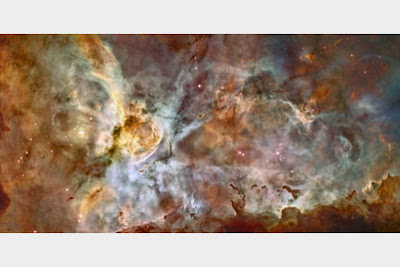Hello Friends!
It's been SO LONG since I've checked in. I think having the holidays behind us now will help. We've also just gone through the "one year mark" of Brent's going to his HEAVENLY HOME. It was all so hard, but I've learned that if we give it to GOD EVERY DAY HE WILL carry our burdens. Even better than that... HE WILL CARRY US!
I do hope to get back into a routine of updating here and on Brent's site. You all have been so sweet and supportive. I hope in time to visit each of you at your blogs. I'm still relatively new to the blogging world (although I kept up our son's site for almost 3 years now). Somehow "blogging" is different. At any rate.. I do look forward to vising you all and making even more new friends. (Perhaps a better way to put it is "meeting my sisters in Christ?" =-)
Okay.. so I saw something really neat on AOL the other day and wanted to share it here. GOD'S "handiwork" just BLOWS me away! I KNOW you'll enjoy the pictures too! (The pictures AND the information on them was taken directly from AOL)
I pray you have a WONDERFUL weekend! Prepared to have your socks knocked OFF!
Even galaxies get bullied. Here, a so-called "death star galaxy" blasts a nearby galaxy with a jet of energy. Scientists said that if this happened in the Milky Way, it would likely destroy all life on Earth.

Feel like you are being watched? This infrared image from NASA's Spitzer Space Telescope shows the Helix nebula, a cosmic starlet notable for its vivid colors and eerie resemblance to a giant eye.

The Cassini spacecraft's 2005 flyby of Saturn's moon Hyperion reveal its sponge-textured surface. This image was colored to bring out the surface's details. Hyperion has a notably reddish tint when viewed in natural color.

This star is ending its life by casting off its outer layers of gas, forming a cocoon around the star's remaining core. The burned-out star, called a white dwarf, is the white dot in the center.

Though Jupiter looks like it has a mild case of the measles, the five spots scattered across the upper half of the planet are actually a rare alignment of some of Jupiter's moons and the shadows they are casting.

Here, bright blue newly formed stars are blowing a cavity in the center of a star-forming region and eroding the outer portions of the nebula, with numerous galaxies delivering a grand backdrop for the stellar newcomers.

The small open star cluster lies in the core of the large emission nebula in Sagittarius, about 8,000 light-years away from Earth. Some of the stars in this cluster are extremely massive and emit intense ultraviolet radiation.

Hubble Heritage Team / ESA / NASA
This is one of the largest panoramic images ever taken with Hubble's cameras, a 50-light-year-wide view of the central region of the Carina Nebula where a maelstrom of a star's birth and death is taking place.

ESA / NASA
These are views of an unusual phenomenon called a light echo. Light from an erupted star continues outward through a cloud of dust surrounding the star. The light reflects or "echoes" off the dust and then travels to Earth.

NASA / AP
This eerie-looking Eagle Nebula, a tall, dense tower of gas, is one of three-quarters of a million photos of the cosmos taken by the Hubble Telescope
Getty Images
This image of the Whirlpool Galaxy is one of the sharpest Hubble has ever produced. The telescope has obited the Earth for 15 years and has taken more than 700,000 images of the comos.

This is one of the universe's most photogenic galaxies, the Sombrero Galaxy. Its hallmark is a brilliant white, bulbous core encircled by thick dust lanes comprising the spiral structure of the galaxy.

Resembling the fury of a raging sea, this is actually a bubbly ocean of glowing hydrogen gas and small amounts of other elements such as oxygen and sulfur within the Omega or Swan Nebula

JPL / NASA
This dramatic shot of the Orion Nebula offers a peek inside a cavern of roiling dust and gas where thousands of stars are forming. More than 3,000 stars appear here, some of which have never been seen in visible light.

Jeff Hester, Arizona State University / ESA / NASA
The Crab Nebula is a six-light-year-wide expanding remnant of a star's supernova explosion. Japanese and Chinese astronomers witnessed this violent event in 1054.

Dan Bayer, The Hutchinson News / AP
Comet Hale-Bopp passes over a rural Rice County, Kan., windmill, just north of Hutchinson, Kan., on Thurday, March 27, 1997

STScI / ESA / NASA
The Hubble Space Telescope "caught" the Boomerang Nebula, which is a reflecting cloud of dust and gas with two nearly symmetric lobes of matter that are being ejected from a central star.

NASA
This nebula is the glowing remains of a dying, sun-like star. This stellar relic is called the Eskimo Nebula because, when viewed through ground-based telescopes, it resembles a face surrounded by a fur parka.

ST-ECF, ESA / NASA
A pair of huge interstellar "twisters" -- eerie funnels reminiscent of terrestrial tornadoes -- are seen in the heart of the Lagoon Nebula about 5,000 light-years from Earth.

Peter Tuthill, Palomar / Keck
The Red Square is among the most symmetrical objects ever observed. It was created by a dying star spewing its innards from opposite poles into space.
Romans 1:19-20
New Living Translation
19 They know the truth about God because He has made it obvious to them. 20 For ever since the world was created, people have seen the earth and sky. Through everything God made, they can clearly see His invisible qualities—His eternal power and divine nature. So they have no excuse for not knowing God.







![[Click here to find out more]](http://i33.tinypic.com/egs2lx.jpg)
![[Click here to find out more]](http://i13.tinypic.com/7xv1hjc.jpg)
![[Click here to find out more]](http://i7.tinypic.com/8a5idqx.jpg)




















